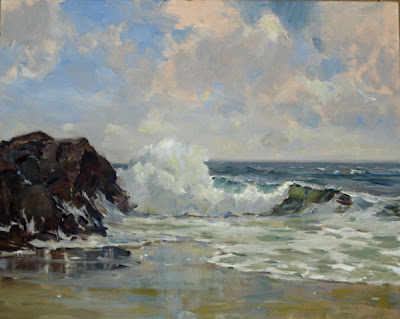 Above is a breaker, I shot a lot of them to get one this perfect. It is almost the ideal wave. I am going to begin talking about the anatomy of a wave by referring you to your John Carlson book. It IS the text for this blog, I guess. In the book he talks about the law of consequent angles.
Above is a breaker, I shot a lot of them to get one this perfect. It is almost the ideal wave. I am going to begin talking about the anatomy of a wave by referring you to your John Carlson book. It IS the text for this blog, I guess. In the book he talks about the law of consequent angles.For those of you who don't know about that, it is a system for understanding the values before us in a landscape, depending upon the angle the various planes present to the sky, or light source. Something that sticks up from the ground or surface like a wall, presents no planes to the light and is therefore darkest in value . The surface of the earth or water presents all of itself to the light, like a floor and therefore is high in value. Planes that are slanting upwards like ramps from the "floor" receive more light depending upon their consequent angles to the light. If you have Carlsons book reread the chapter on this again, it will help you through the understanding of that which is to follow in the coming posts.
The technique of painting waves and seascape requires understanding how the surface anatomy turns their form toward or away from the light. A seascape painter uses the anatomical knowledge of how waves are shaped to know which way EVERY plane on their surface is facing. This combined with knowledge from observation of the water itself enables the seascape painter to invent the surf. There are many planes, perhaps dozens in a wave. In order to paint them you need to know which way they are all facing. To make this even more complex, most of them are mirrors.
AS an example, look over at the left hand side of that wave, to the left of the break. There are two major value areas there. They are the upright "wave: forms that rise like walls, and the top planes that "ramp' upwards and reflect the sky. All over the body of the wave and the surface of the water similar planes are doing the same thing, many of them are pointed like mountains, in fact the up planes in a wave tend to resemble mountain ranges. Notice the "floor" in front of the wave, it is of a higher key than the rising planes of the front of the wave and below the foam of the wave it's mirror like quality is displayed. These are the sort of things that I will be discussing in the upcoming posts, as I lay out in a hopefully orderly fashion the structure of the parts of an ideal wave.
I received an e-mail today from the Old Lyme Art Association saying that the lower level of their historic building, containing their studios, has been flooded. The building is close to the Lieutenant river which must be very high. Those of you outside New England may be unaware that we have had, and continue to receive record rainfall amounts. Boston is in a state of emergency with the National Guard called out. I am supposed to deliver a painting for a show at the Guild tomorrow, I hope I can get there.
Reproduced below is their e- mail to me;
The Lyme Art Association has suffered significant flood damage from this week's rain, and the downstairs studio will be closed through the week. Any classes scheduled this week are CANCELED unless you hear otherwise from us.
Both downstairs computers have been damaged in the flood. They held important Education databases and class rosters. If you have registered for a class this spring, please help us by calling the LAA between 10am and 5pm and giving us your enrollment information again. Please be patient if you get a busy signal - we only have 2 phone lines.
Thank you in advance for your patience and support as we recover from this disaster. Our upstairs galleries did not suffer any water damage and will be open all week.
With kindest regards,
Susan Ballek
Executive Director










































